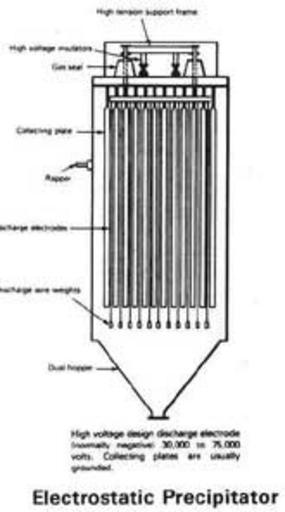MAKE A MEME
View Large Image

| View Original: | Electrostatic_p.jpg (165x296) | |||
| Download: | Original | Medium | Small | Thumb |
| Courtesy of: | commons.wikimedia.org | More Like This | ||
| Keywords: Electrostatic p.jpg See dust collector<br /> Electrostatic Precipitators use electrostatic forces to separate dust particles from exhaust gases A number of high-voltage direct-current discharge electrodes are placed between grounded collecting electrodes The contaminated gases flow through the passage formed by the discharge and collecting electrodes The airborne particles receive a negative charge as they pass through the ionized field between the electrodes These charged particles are then attracted to a grounded or positively charged electrode and adhere to it The collected material on the electrodes is removed by rapping or vibrating the collecting electrodes either continuously or at a predetermined interval Cleaning a precipitator can usually be done without interrupting the airflow The four main components of all electrostatic precipitators are Power supply unit to provide high-voltage unidirectional current Ionizing section to impart a charge to particulates int he gas stream A means of removing the collected particulates A housing to enclose the precipitator zone The following factors affect the efficiency of electrostatic precipitators Larger collection-surface areas and lower gas-flow rates increase efficiency because of the increased time available for electrical activity to treat the dust particles An increase in the dust-particle migration velocity to the collecting electrodes increases efficiency The migration velocity can be increased by- Decreasing the gas viscosity Increasing the gas temperature Increasing the voltage field Unknown<br /> 2006-02-16 OSHA / US Department of Labor Transferred from http //en wikipedia org en wikipedia by SreeBot Unknown US government<br /> Uploaded by Ignaciomella at en wikipedia PD-USGov other versions PD-USGov Original upload log page en wikipedia Electrostatic_p jpg Upload date User Bytes Dimensions Comment 2006-02-16 18 53 UTC Ignaciomella 8170 bytes 165×296 <small><nowiki>Electrostatic Precipitators Electrostatic Precipitator Electrostatic Precipitators use electrostatic forces to separate dust particles from exhaust gases A number of high-voltage direct-current discharge electrodes are placed between grounded collecti</nowiki></small> Electrostatic precipitators | ||||